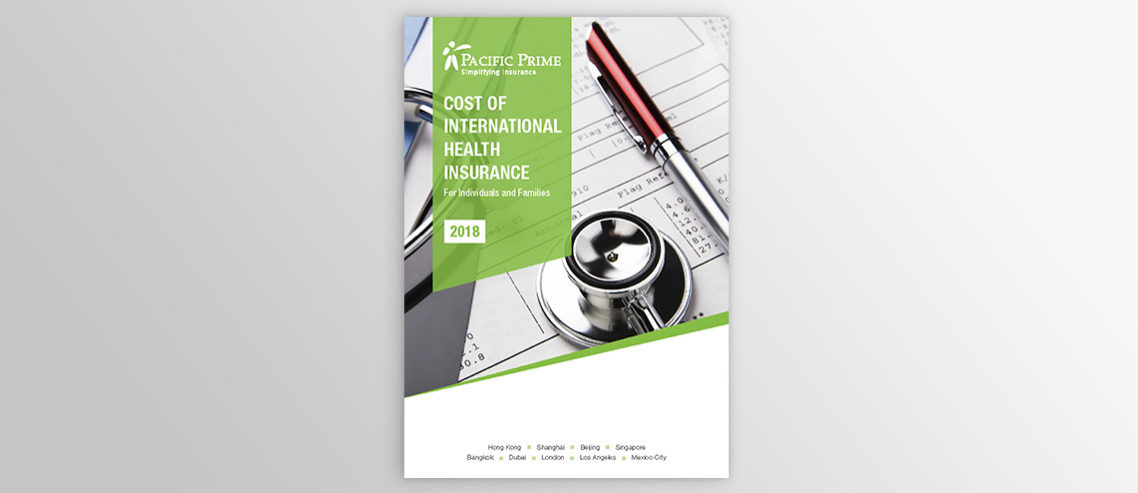What can we tell from the trend of increasing global insurance premiums?
That the cost of health insurance has been on the rise steadily for years is something you may already know. However, it might not be easy for you to read between the numbers and identify trend patterns as well as contributing factors, especially if you aren’t very familiar with the details of insurance landscapes in different countries. It’s almost like, as the Chinese proverb says, “stay in treasure mountain but get nothing”. That’s why in our 2018 edition of our Cost of Health Insurance report, our professional insurance specialists here at Pacific Prime Thailand not only present numbers and charts based on the data from seven major insurers in 100 countries, but also curate a wealth of objective findings and important analysis for your reference.
While our previous article focuses more on the ranking of the top 20 and bottom 5 most expensive countries for international private medical insurance (IPMI), this article is going to provide a simplified version of some of our key analysis. We believe these findings are not only interesting to anyone with an IPMI plan, but also point to potential future trends that both individuals and businesses should be aware of.
1. Three of the top 20 most expensive countries have seen increased rankings
This year, three countries have seen drastic increases in rankings, namely Indonesia, Canada, and Dubai.
Indonesia has jumped from 19th in 2017 to 6th in 2018
Indonesia’s huge jump in ranking has put this historically lower cost nation right behind China this year. We believe the market is the main driving force behind this phenomenon. More specifically, the ‘market’ refers to the expanding middle to upper class, which is not only increasing in wealth but also mobility.
The rising mobility means that more Indonesians are likely to secure overseas medical insurance products, among which IPMI is the prime choice. To back this assumption up, we have observed an uptick in demand of IPMI from Indonesians in our office at Singapore, a location largely lauded as the hub of medical tourism.
For an in-depth analysis of the factors that contributed to the jump in rankings of Canada and Dubai, you can refer to the complete version of our Cost of Health Insurance Report here.
2. The gap between premiums in the US and everywhere else has increased
In this year’s report, the US not only continues to be the most expensive country to purchase IMPI, but the gap between average IPMI premiums in the US and in the 99 other countries has also expanded.
| % difference with the US included | ||||
| Region | Country | 2018 % of | 2017 % of | Increase – points |
| The Americas | US | 100% | 100% | 0.0 |
| Asia | Hong Kong | 63.81% | 55.91% | -7.9 |
| The Americas | Canada | 52.03% | 44.82% | -7.2 |
| The Middle East | Dubai | 45.42% | 42.89% | -2.5 |
| Asia | China | 54.22% | 41.69% | -12.5 |
The greater discrepancy is not only due to the increasing costs in the US but also because of the decreasing average premiums in some locations. Some other factors, which we have discussed in our 2017 iteration, continue to be relevant this year, including a high prevalence of chronic diseases, high prices for medicine and medical technology, and disparate pricing for medical care.
3. The Americas has emerged as a dominant region in the top 20 most expensive locations
A number of countries in the Americas carry the same average premiums, and thus they have the same rankings. Therefore, among the 28 countries comprising the top 20 most expensive locations, 14 of them are from the Americas.
We believe that this is owing to the higher costs of care in North America. The high cost of IPMI in the US is also affecting neighboring countries such as Canada and Mexico.
Additionally, some insurers set their premiums based on regions, which means that they tend to group countries in certain geographical locations together so as to streamline their underwriting process. Although this is not the universal pricing method, it still has a certain degree of impact on the averages.
We are seeing an increasing demand for IPMI plans in Middle and South America, especially in countries with larger expat populations. The high inflation rates in places such as Argentina and Mexico further compound to this demand.
High medical costs are also attributable to the phenomenon. According to AON’s 2018 Global Medical Trend Rates report, the average medical trend rate for South America is the second highest of any region in the world.
The last factor is the way people use IPMI plans in the Americas. The lack of local quality healthcare, as well as socio-political unrest in many Middle and South America countries means that many citizens go abroad for medical treatments, with the US being a top destination. Since IPMI is the only form of insurance available for medical tourism, this pushes up demand for the product.
Download the 2018 Cost of International Health Insurance Report
The above illustrates just some of the key findings from our Cost of International Health Insurance report, which is one of the most important resources we create each year. It is completely free, and available in two versions: an online version featuring selected information, and a PDF version covering full rankings and complete analysis.For a pared-down look at our report, which contains our rankings and analysis sections (primary global drivers behind the cost of IPMI), you may read our online version here.
For a complete ranking of the average cost of medical insurance in 100 countries for different demographics, as well as our full-length analysis on the key drivers behind the five pivotal findings, download a free copy of our full report in PDF format here.
With over 18 years of experience, Pacific Prime is an experienced insurance broker that offers impartial advice to help clients find insurance solutions that meet their needs. Contact us for any insurance-related questions you have, and get a free quote and a plan comparison!
- How much do COVID-19 tests cost for expats in Bangkok, Thailand? (Updated January 2023) - January 6, 2023
- How to maintain relationships in self-isolation - August 2, 2021
- The latest dine-in restrictions in Thailand - May 6, 2021





Comments
Comments for this post are closed.
We'll notify you
when our team replies!